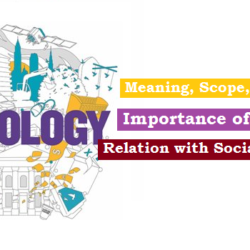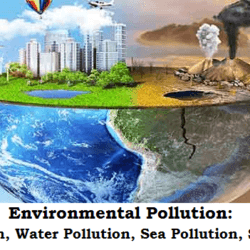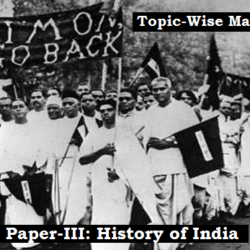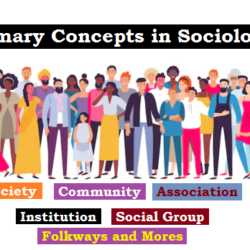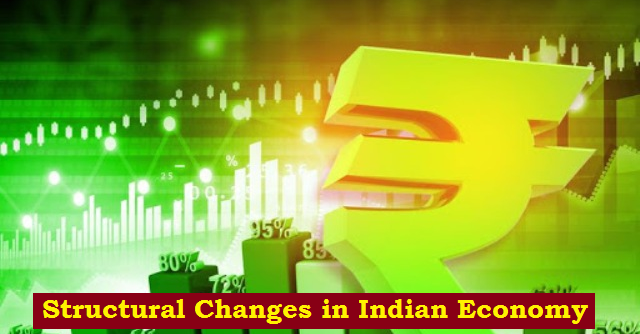
The World Economic Outlook of October 2019 has estimated India’s economy to become the fifth largest in the world, as measured using GDP at current US$ prices, moving past United Kingdom and France. The size of the economy is estimated at US$ 2.9 trillion in 2019.

Main Sectors of a GDP:
- Agriculture and allied services (Primary Sector): includes forestry, fishing and animal husbandry
- Industry (Secondary Sector): includes Mining & Quarrying, Manufacturing, Electricity, Gas, Water supply & other utility services and Construction
- Services (Tertiary Sector): includes Trade, Hotel, Transport, Storage, Communication and services related to broadcasting; Financial, Real estate & Professional services; Public Administration, Defence and other services
Sectoral GDP Share (India)
| Sectors | 1950-51 | 1970-71 | 1990-91 | 2000-01 | 2018-19 |
| Agriculture and allied Services | 51.9 | 41.7 | 29.5 | 22.3 | 16.1 |
| Industry | 11.1 | 16.0 | 20.6 | 20.7 | 29.6 |
| Services | 34.6 | 40.9 | 49.6 | 57.0 | 54.3 |
Sources: Economic Survey 2019-20 | Research Gate
Sectoral GDP Share (Chhattisgarh)
| Sectors | 2011-12 | 2016-17 | 2019-20 (E) |
| Agriculture and allied Services | 18.1 | 15.2 | 16.8 |
| Industry | 47.3 | 49.2 | 46.2 |
| Services | 34.6 | 35.6 | 37.0 |
Source: Economic Survey of CG 2019-20
Structural Changes in Workforce
With differential growth of employment among different sectors of the economy, there have obviously been changes in the structure of employment. Among the three major sectors by broad division of economic activity, namely, agriculture, industry and services, there has been a decline, as expected, in the share of agriculture. The changing trends of the workforce are given below:
| Sectors | 1950-51 | 1970-71 | 1990-91 | 2000-01 | 2018-19 |
| Agriculture and allied Services | 72.1 | 72.1 | 66.8 | 56.7 | 43.2 |
| Industry | 10.6 | 11.2 | 12.7 | 17.5 | 24.9 |
| Services | 17.3 | 16.7 | 20.5 | 25.8 | 31.9 |
Source: Article
It has been generally expected that with shift of workers from agriculture to non‐agricultural activities there will be an increase in the proportion of workers employed on a regular wage and salary basis. However, there has been a decline in the share of regular workers and the share of casual workers has increased.
The shift is seen from self‐employed to casual workers category (called as ‘Casualizationʹ of workforce) and most of it has taken place in rural areas, from agriculture to non‐agricultural activities, such as construction, trade and services.
Changes in Role of Public and Private Sectors
Since the Indian economy consists of both privately owned and government owned business enterprises, it is known as a mixed economy. The private sector consists of business owned by individuals or a group of individuals, while the public sector consists of various organizations owned and managed by the government.
Industrial Policy:
The government in its industrial policy resolutions, from time-to-time, defines the area of activities in which the private sector and public sector are allowed to operate.
- Industrial Policy Resolution 1948: the Government of India had specified the approach towards development of the industrial sector. The roles of the private and public sector were clearly defined.
- Industrial Policy Resolution, 1956: also laid down certain objectives for the public sector to follow so as to accelerate the rate of growth and industrialization. The public sector was given a lot of importance but at the same time mutual dependency of public and private sectors was emphasized.
- Industrial Policy Resolution, 1991: It was radically different from all the earlier policies where the government was deliberating disinvestment of public sector and allowing greater freedom to the private sector.
- Abolition of licensing of industries (except environment and security related)
- Only 8 industries were reserved for the public sector, they were restricted to atomic energy, arms and communication, mining, and railways. Later it was reduced to only 3 (atomic energy, railways, defence)
- FERA was replaced with FEMA to encourage foreign direct investment (FDI) from business houses outside India. Thus, we have public sector units, private sector enterprises and global enterprises coexisting in the Indian economy.
Government Policy towards the Public Sector: Since 1991
The Government of India had introduced four major reforms in the public sector in its New Industrial Policy in 1991. The main elements of the Government policy are as follows:
- Restructure and revive potentially viable PSUs
- Close down PSUs, which cannot be revived
- Bring down governments equity in all non-strategic PSUs to 26 per cent or lower, if necessary
- Fully protect the interest of workers
Present Government policy with public sector enterprises includes:
- Divest government stake in many areas including banking to the extent of 49 per cent and retain control to fulfill social, economic and strategic considerations.
- It had decided to carry out strategic sale like Air India to improve efficiency and save taxpayers money in bailing them out year-after-year.
- It has decided to exit from areas where private sector can do a better job.
- In case of sick undertakings, it will try to go for outright sale if attempts to revive failed.
- To utilize the huge land available with public sector companies for setting up more units, utilizing huge cash piled up with profit-making public sector enterprises.
Role of Public Sector in Economic Development:
- Industrial development:
- Public Sector Enterprises formed the backbone of industrial development of the country in Independent India.
- Public sector got into areas of basic and heavy industries where private sector would not venture into as they did not have the financial muscle or wherewithal.
- Removed regional imbalances: Public sector also helped in removing regional imbalances, development of infrastructure, townships and remote areas.
- Socio-economic development of India: Initially its role was to help create the much needed industrial base and infrastructure apart from bringing about price stabilization and socio-economic development.
- PSEs contributed greatly to job creation by adopting labour-intensive techniques in the early part of independence, nationalization of sick textile units and setting up ancillary industries around major units subsequently.
- Subsequently Government was forced to nationalized some sick unites particularly in textiles industry to protect the interest of worker.
- Globally competitive: With the economic liberalization in 1991, its role changed to take on competition including global.
Contribution of Private and Public Sector in GDP
| Sectors | 2004-05 | 2006-07 | 2010-11 |
| Private | 77.0 | 79.3 | 79.0 |
| Public | 23.0 | 20.7 | 21.0 |
Source: Govt Data
Role of Private Sector in Economic Development:
- Share in GDP: Private sector has a share of more than 70% in the GDP of the country. A huge number of large scale, small scale, cottage scale units are under the control of private sector.
- Employment generation: Private sector generates more employment as compared to the public sector as it covers areas like agriculture, food processing, cottage and SMEs, etc.
- Innovation and introduction of new technology: Private sector relies on continuous innovation and introduction of latest technology in order to compete in the market.
- Supplement the Govts’ efforts: Private sectors’ innovation and technological advancement supplements the need of the Govt in providing various services to people and help in the socio-economic development of the nation.

 Home
Home Syllabus
Syllabus Contact Us
Contact Us

